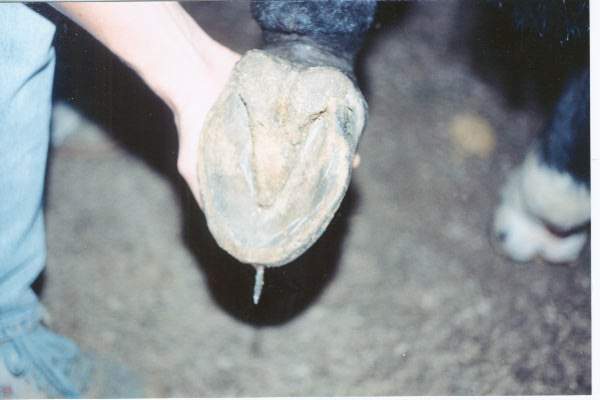Creseida, This back foot would be a prime candidate for a toe clip in my opinion. Not to knock your guy, but the lateral clip is hammered down into the hoof wall, and almost flat. Why not just grind it off???
If the horse was in hard work with a lot of twisting action on the foot, move the clip forward to the area of the first nail hole.
I think back at the beginning of this thread I talked about toe clips on back feet. ![]()
Regards John
I hope this thread is around in a week or so…it will take that long for the 1’+ deep mud to dissipate so that I can find my horse’s feet again, at least long enough to take a picture. 
~<>~ Remember, the Ark was built by a rank amateur; the Titanic was built by a team of experts~<>~
Feet pictures? I’ve got feet pictures… I’d love to hear comments about my guys feet… he’s been to hell & back again with farriers.
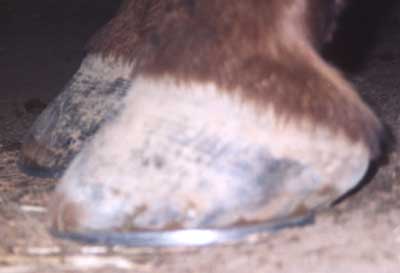
HossShoer…you would think to look at it that there would be muscle soreness issues…but that doesn’t seem to be the case. In fact, because many horses were already suffering severe pain with stiffness (either from chronic founder or severely deformed feet), the trimmers note that there is a fast softening and relaxing of the muscles in the shoulder, back, and neck.
Martha…the lameness is common and accepted practice in Strasser trims. It is most likely abscessing…occassionally, it is laminitis, but if that is the case, then it is blamed on the owner as improper management, not the trim. The premis behind accepting abscessing…sometimes as long as a year or more after the trim is initiated…is that the foot is so compromised from shoeing that there is a great deal of necrotic tissue in the foot from a lack of circulation. When the foot functions properly (the result of a Strasser trim), the circulation returns, the damaged and dead tissue is then removed via abscessing. It is noted by the trimmers that this is expected and good for the horse. It is an indication of the foot being returned to optimal form and function…part of the healing process. However, IMO, Strasser doesn’t teach about how loss of hoof integrity can result in a damaged corium and thus abscessing. I have asked CHCS about the differences and how they can tell if they are causing the damage or it is part of the healing process…the standard answer was that they would certainly know if they were causing the damage (but they didn’t say how) and that they had only encountered this as an expected part of the healing process…even a year or more later.
Jreventer…you raise a good point about “creating” underrun heels with this trim. Many of the DIY trimmers seemed to have difficulting…even after attending several clinics…keeping the heels back where they belong. They would often be starting with underrun heels and couldn’t get rid of them, but some actually produced them with this trim. Some would argue that they misapplied the trim, but IMO, some of these people seemed very knowledgable and now that they have changed methods to one more like Natural Balance (backing up the toe) they no longer have difficulting resolving these issues.
slb, gee ya keep some late/early hours there.LOL
The feet look sorta Ok, maybe a little long in the toe. There’s enough gunk on 'em to grease a pig. Looks like nail holes at the front. They were nice and high whenever the shoes went on.
OK so which “big name” used him as a demo???
Regards John
Here is another horse also done by the above farrier. She has natural balance shoes on, and we are gradually trying to shorten the toe and get more heel support. Advice, opinions, please? Thanks!
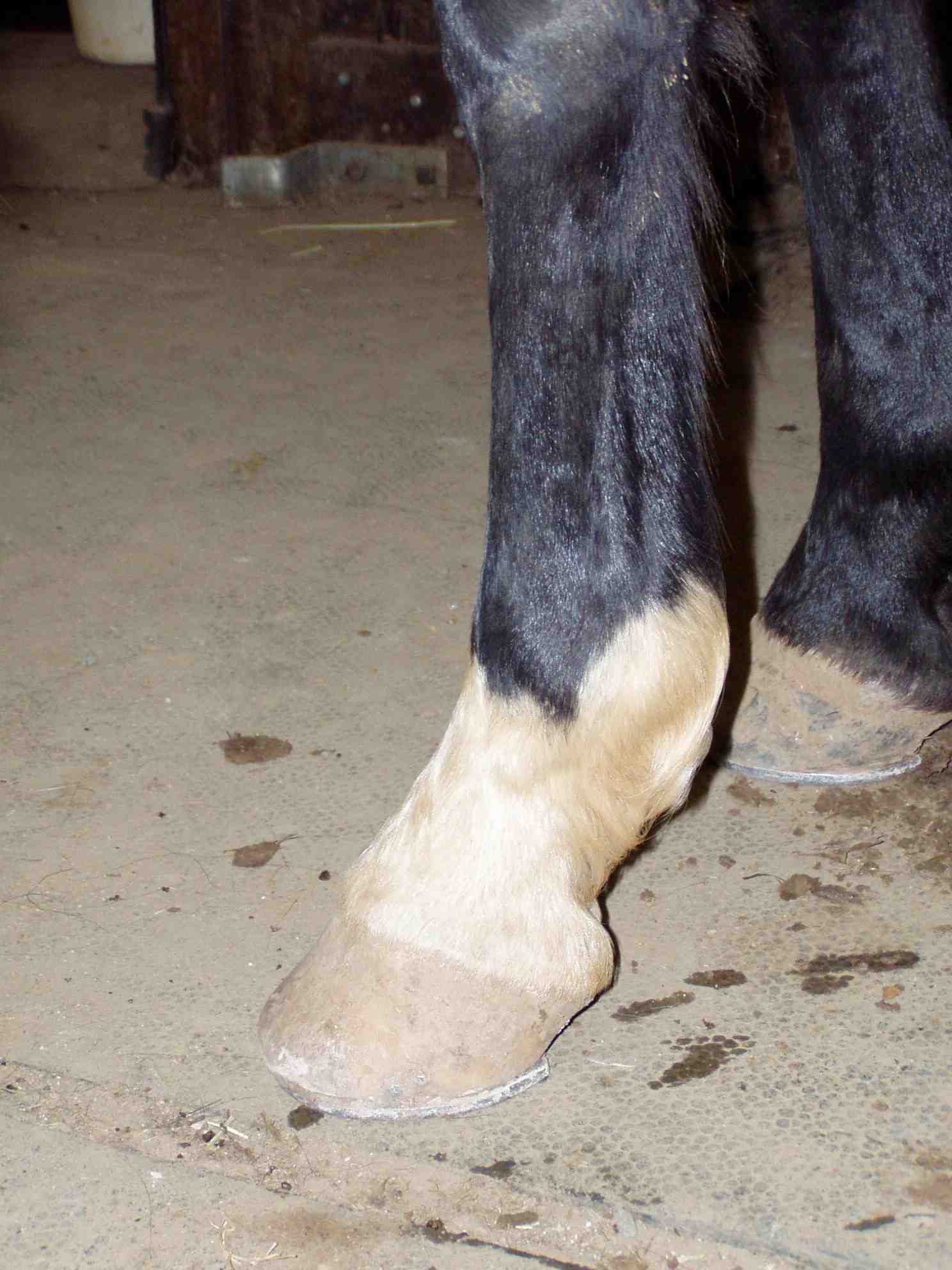
What program are you using? You should have a tool that allows you to resize the image. If it is in pixels, consider that 640x480 will fill a low res computer screen…try making them about 250-300, but make sure that if you have to enter 2 dimetions that they are directly proportional…other wise you will distort your picture.
Try right clicking…sometimes you can find a resize thing there. Look under edit or image on the tool bar.
If you can’t do it…you can send it to me…but if it was too big to put up, it will probably be too big to send in an email also.
Regarding the comments on Cressy’s feet…
<BLOCKQUOTE class=“ip-ubbcode-quote”><font size="-1">quote:</font><HR>Originally posted by slb:
Observing the striping in the hoof wall, you can see that they are “curved” looking. There is a slight dish in the foot…this means the horn tubles are not growing straight…toe wants to run forward and heel will go with it.
<HR></BLOCKQUOTE>
I also notice that PrettyFilly’s 3-yr old has dished feet in her last post - similar to Cressy’s.
So my question is - how does one fix this? You said the horn tubules aren’t growing straight. I’m not entirely sure what that means anatomically… but more importantly, I’m curious how you correct it. This is interesting.
Do some horse’s have a “dish” to their hoof by nature of their confirmation and it’s “ok”? Is this always somethign that is a result of “improper shoeing” or maybe better said, feet getting unbalanced over time…?
martha
Yea! - we see Ben’s pictures! ![]()
Interesting to note about the coffin bone/club footed progression…
So I was talking to my trainer about Java’s underrun heels (which aren’t too bad, but could stand a bit more correction). See pictures on page 1. ![]()
He said that the fastest and most effective way to fix underrun heels is to cut the heel off so the base of support at the heel is back where it belongs because you cut off the long part of it which grows at an angle forward.
I haven’t precisely heard this cut and dry advice yet for this problem. We still want to keep his toes squared back so the breakover is where it belongs, but do you also cut off the long forward heel to bring about a change?
I’m planning to discuss this all with my farrier in a week or so when he comes out for Trim #2 in the pursuit of good feet. I want to be armed with knowledgable ideas!
martha
**Give a person a fish and you feed them for a day; teach that person to use the Internet and they won’t bother you for weeks. **
Okay, next question. Deep crack that runs straight up the very toe, ending just below the corornary band, about 1/4" below. Crack is deep but has not spread.
I have a mare with this. 2 summers ago she gravelled up this toe. Will it be possible for her to grow this out or am I looking at shoes and laces?
Proud member of the “I Hate Physical Therapy” clique | Auction for Aiden!
YaBB me baby! http://www.hopefulfarm.com/cgi-bin/yabb/YaBB.cgi
12 year old TB in steel egg-bar with snow pads left front
Kathleen
http://www.grayhorsestudio.com
*member of artist clique
*devout worshipper of the American Thoroughbred
*member of the vertically-gifted clique
*owner of the most expensive “cheap” horse and dog EVER
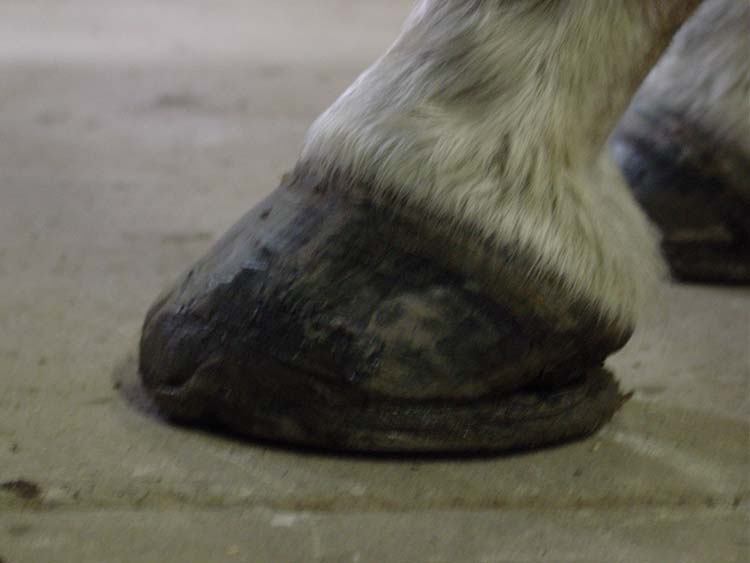
Any thoughts on what caused this?
~<>~ Remember, the Ark was built by a rank amateur; the Titanic was built by a team of experts~<>~
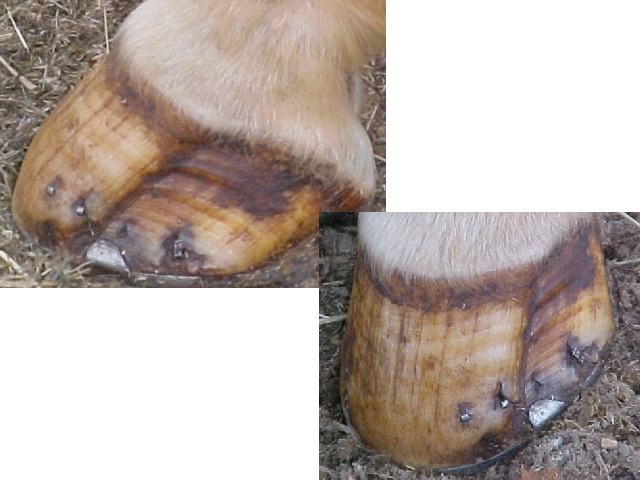
OK, I’ll jump. I have 4 horses, but currently only pics of one of their feet. They are all barefoot, including our 3 yr old ottb who had his shoes pulled last week.
Here is my 16 yr old 14.2 hh haflinger cross pony. She has been barefoot her entire life. Never taken a lame step.
Left front:
http://community.webshots.com/photo/60479273/60479322LkuNny
Solar:
http://community.webshots.com/photo/60479273/60479366gjsDcv
both fronts:
http://community.webshots.com/photo/60479273/60479566oOBQiB
She has some darn tough feet, that crack you can see in her left front used to be almost all the way up to the coronary band, it has grown out some. Her feet get occasional chips/breaks. We very nearly put shoes on her this summer, she was having an awful time with getting chunks taken out of her feet, but she is horrendous to have foot work done, she is at the point where she doesnt have to be tranqed anymore, but is still a bit of a monster.
Here she is to compare her body to feet:
http://community.webshots.com/photo/57926340/57926474etNyHM
Here’s a pic of Lexi’s feet, taken the day we got her. She was 3 years old and had lived outside all her life… most recently in a ROCK QUARRY for 7 months until we bought her.
I’ll take new pics of her feet and all the rest of ems feet tomorrow. Jez’s feet are very ahem interesting… she has 4 totally different feet. My farrier has only recently started shoeing her, so he’s taking it slow trying to correct everything.
-Amanda
Look Up, Keep Kicking
www.risingstarfarm.net
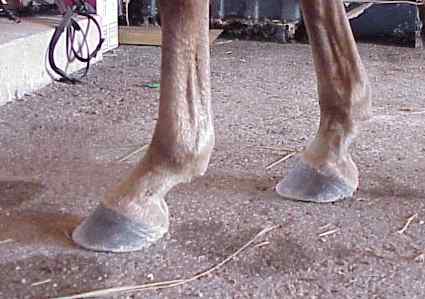
Oh Goody!
Ben was reset yesterday, and so now would be a good time to take some pics of his feet. Both fronts are now at 54 degrees – odd to have the club and non-clubby one matching! ![]()
I need to scan some of the pics from the last computer balancing. But, I’d have to stay home for more than a few hours to sleep to do that, so it hasn’t happened.
Unfortunately my mom made off with the digital camera (fooey, doesn’t she understand that since I’ve had it more than a year, it should now be mine?!!) so I’ll have to borrow one, or do the real photos and scan them route. I’ll work on it this weekend and post some for your perusal.
The little monster is getting reset this afternoon, and since racing on a poor shoeing/trimming job is the cause of both the ugly old bow and his arthritis in the other ankle, it might be interesting to see what we are doing with his feet without the computer’s input (I haven’t been able to afford to do both boys feet with x-rays)
I’ll snap some pics today ![]()
Libby
OK…going out on a limb here as I am neither a farrier or trimmer. But, here is my understanding of the issue of underrun heels.
I believe that trimming the heels back if they are tall or underrun is key to getting these horses to help “correct” themselves. Either type of heel generally results in some dysfunction in the rear part of the foot and can contribute to navicular syndrome or heel pain. This results in a cycle of not weighting the heel…growing more heel…causing more pain. After a while, you have a “navicular” horse walking on its toes.
The outer hoof capsule needs to be aligned with the coffin bone and excess heel (in any form) causes the hoof capsule to lose that correct alignment. Without addressing the heel, the foot will most likely keep creeping forward. There can be no restructuring of the horn tubules and thus, no correcting the underrun heels.
The object is to get the base of support rearward, under the foot. To do this, many times wedges are applied, but IMO, this often only serves to crush the heels more. Occassionally once the heels are the correct height, wedges do need to be applied short term to help correct alignement. But, they should never be left on long term. Also, frog and bar support is often overlooked in cases like this. If shod, frog and bar support are imperative as ground contact of the frog is key to healing these feet. It doesn’t matter how it is done, but it needs to be. The reason is that in horses with underrun heels, sometimes the frog and most generally the digital cushion have lost integrity. This will get worse over time without frog support. Eventually, the frog will prolapse through the shoe in an attempt to touch the ground to support the rear of the foot.
Hope this makes sense ![]()
<BLOCKQUOTE class=“ip-ubbcode-quote”><font size="-1">quote:</font><HR>Originally posted by HossShoer:
Creseida, This back foot would be a prime candidate for a toe clip in my opinion. Not to knock your guy, but the lateral clip is hammered down into the hoof wall, and almost flat. Why not just grind it off???
If the horse was in hard work with a lot of twisting action on the foot, move the clip forward to the area of the first nail hole.
I think back at the beginning of this thread I talked about toe clips on back feet. ![]()
Regards John<HR></BLOCKQUOTE>
Hi John,
Sorry so late in replying…I have a question (ok more than one)
Can you explain your reasoning on why a toe clip would be beneficial behind, especially in this case? How would that keep the shoe from twisting sideways, which is why this particular horse wears clips in the first place. Thanks!
~<>~ COTHBB Leather Care Guru~<>~
~Member of the Horse Vans Rock clique~
OOPS! Sorry Fairweather! ![]()
Cressy “solar” view
~<>~ Remember, the Ark was built by a rank amateur; the Titanic was built by a team of experts~<>~

LOL HS ![]()
This is a GP jumper mare that kicked in her stall, a lot.That’s a nail with the head of it in her foot, just short of the P3. ( The Vet has the x-ray and still keeps it for lectures.) We pulled it with a pair of vice grips. It bled a little and was on antiboiotics for awhile. But she was back to work in no time at all.
